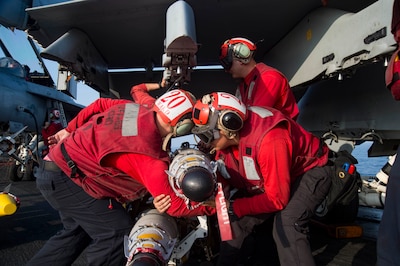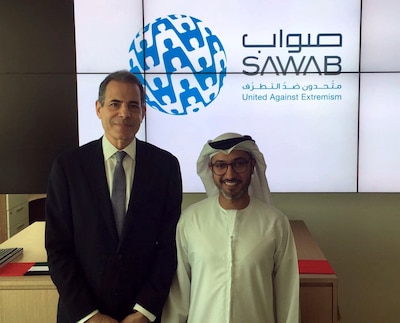The U.S.-led multinational coalition is making progress in Iraq and Syria against the Islamic State of Iraq and the Levant and against its networks and affiliates, but an unprecedented terrorist challenge remains for nations everywhere, the presidential envoy for the global coalition to counter ISIL said June 28.
State Department official Brett McGurk testified before the Senate Foreign Relations Committee, noting that the global campaign plan being carried out by 66 coalition partner nations focuses on three areas for defeating ISIL.

Sailors prepare to load ordnance onto a Navy F/A-18E Super Hornet assigned to Strike Fighter Squadron 86 on the flight deck of the aircraft carrier USS Dwight D. Eisenhower, deployed in the Mediterranean Sea, June 28, 2016. The USS Eisenhower is deployed in support of Operation Inherent Resolve, the U.S.-led coalition to degrade and defeat the Islamic State of Iraq and the Levant. Navy photo by Petty Officer 3rd Class Anderson W. Branch
“We analyze ISIL in three dimensions,” he told the panel. “The core in Iraq and Syria; the networks that feed its strength -- foreign fighter networks, propaganda networks and financial networks; and the global affiliates … eight in all, that seek to expand its reach, with Libya and Sinai being the most significant.”
McGurk said that of the indicators used to track ISIL -- morale, territory, combat-ready fighters, access to revenue, access to borders, capable and confident leadership, social media and global branches -- many are trending in the right direction.
Dismantling ISIL
The number of foreign fighters joining ISIL is down, he said, and “more countries than ever before are sharing information to identify those who are still traveling. Outside financing has been severed and internal financing has taken a significant hit through painstaking intelligence work and precision targeting by military forces in Iraq and Syria.”
ISIL's propaganda is being challenged 24/7 through a global network of countries, civil society organizations, private companies and individuals, McGurk added, and ISIL leaders are being killed at a rate of one every three days, including ISIL leader Abu Bakr al-Baghdadi's main deputies, Haji Imam and Abu Sayyaf, killed by U.S. military forces.
ISIL's territory is shrinking, he said, and the terrorist army has lost nearly 50 percent of territory it once controlled in Iraq and 20 percent in Syria over the past 18 months.
What makes ISIL different from other terrorist organizations is its attempt to hold territory and establish a self-proclaimed state-like entity in Iraq and Syria that McGurk called a “phony caliphate.”
Taking ISIL Territory
The notion of a caliphate, he added, “has been a primary driver in recruitment for the tens of thousands of foreign fighters that have joined ISIL in Syria and Iraq. The territory it controls also allows ISIL to extract vast resources, and most importantly for us, plan and launch highly sophisticated external attacks.”
McGurk said the attacks in Brussels and Paris, for example, stem from ISIL's external plotting network based in Raqqa and that ISIL has sent operatives from Syria to Europe through an area called the Manbij pocket.
“That is why we must take the territory away from ISIL,” he said. “And, just as important, stabilize areas after ISIL is [ejected].”
As local fighters take back important territory, McGurk added, coalition forces are collecting information about the foreign fighter network, about how it's put together and who leads it.
“That helps us really root it out,” he said, “not only in Iraq and Syria but in the branches and little networks that exist in France and other places.”
Retreating to the Shadows
Two years ago around this time, McGurk said in his written testimony, “I was in Iraq when Abu Bakr al-Baghdadi pronounced the establishment of a caliphate from the largest mosque in Mosul.”
It was Ramadan, he added, and the announcement, despite being denounced by thousands of Muslim leaders and scholars around the world, spiked ISIL recruiting and its adherents’ confidence as a historic movement on the march. Throughout 2014, Baghdadi and other leaders appeared in the open, speaking and recruiting.
“I just returned from another trip to Iraq. It is Ramadan once again yet we have not heard from the so-called caliph in more than six months,” McGurk said. “This Ramadan is being celebrated not by Baghdadi but by millions of Iraqis taking the streets each night as ISIL and its leaders have retreated to the shadows.”
But ISIL still inspires new recruits and lone-wolf attacks around the world, he added.
“This is extraordinarily difficult to stop. We have to remain vigilant. That's why we have a global coalition, not just for Iraq and Syria but to make sure we are attacking the foreign fighter networks and sharing information [and] working with Interpol so, as these people try to travel, they can be picked up,” McGurk said.
“This is something we haven't seen before,” he added, “and [when] you add to it social media and the speed of international travel … it is an unprecedented challenge and it's going to be with us for years.”
Defeating ISIL in Cyberspace
McGurk said ISIL’s social media recruiting efforts are being countered by coalition efforts led by the United Kingdom, the United Arab Emirates and Malaysia, providing counter-ISIL content with localized focus for different regions of the world.
“I have visited the Sawab Center in [the United Arab Emirates], which is led by smart and energetic young people determined to defeat ISIL in cyberspace,” he said in written testimony, “and they are succeeding with innovative media campaigns focused on ISIL defectors and the truth behind what ISIL promises versus what it delivers on the ground -- especially for women.”

Undersecretary of State for Public Diplomacy and Public Affairs Rick Stengel visits the Sawab Center in Abu Dhabi, United Arab Emirates, the first-ever multinational online messaging and engagement program in support of the global coalition against ISIL, April 27, 2016. State Department photo
In the United States, the State Department’s Global Engagement Center coordinates, integrates and synchronizes governmentwide communications activities to counter ISIL messaging, McGurk said.
“The GEC also provides assistance with content-development platforms and amplifying effective voices against the perverse ISIL narrative,” he added.
Countering ISIL Messages
McGurk said Twitter recently announced that it has eliminated nearly 125,000 ISIL-related or -affiliated “handles,” and that number is growing, and Facebook and YouTube are similarly removing ISIL-related content from their platforms.
“Within the coalition, we have widely publicized how anyone can report ISIL content online so platforms can remove it if the content violates a platform’s terms of service, which it often does,” he said.
Such efforts are having an impact, McGurk noted, adding that two years ago ISIL had nearly free reign in cyberspace and today there are reportedly six people opposing ISIL’s message online for each person who supports it.
“We need these numbers to increase,” he said, “and recognize that the most effective voices are not governments but individuals, with their own first-hand accounts of the horror under ISIL rule. As these stories increase, ISIL’s message is on defense and it is our job to help keep it that way.”
(Follow Cheryl Pellerin on Twitter: @PellerinDoDNews)
http://www.defense.gov/News-Article-View/Article/821436/presidential-envoy-reports-counter-isil-progress-ongoing-terrorism-threat


 Download Image
Download Image  Image details page
Image details page 
No comments:
Post a Comment
Note: Only a member of this blog may post a comment.